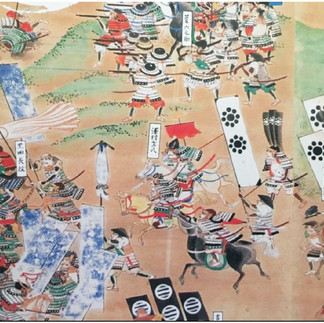History. The Hosokawa clan (細 川 氏) Hosokawa-shi) is a clan of Japanese Samurai.
- academyamasio

- Mar 8, 2022
- 4 min read
The Hosokawa family (Japanese 細 川 氏 Hosokawa-shi) - a Japanese clan of warriors and samurai.
The current cultivator and continuator of the tradition of the great Hosokawa family (Hosokawa Klan) is Hiroshi Hosokawa Hanshi, the founder and leader of the Hosokawa Dojo - Hosokawa Souken Hyouho in the city of Osaka, Japan. The ancestor of Hosokawa Hiroshi Hanshi, Tadatoshi Hosokawa San, was a swordsman of the Tokugawa shogunate during the Tokugawa shogunate era. He was also a military commander in Kyushu and Kumamoto Castle.
He descended from Emperor Seiwa (850-880) and an offshoot of the Minamoto family (through the Ashikaga clan).
During the Ashikaga shogunate, the Hosokawa family had many prominent officials in the administration, and during the Edo period they became one of the largest landowners in Japan. In modern times, one of the descendants of the family, Morihiro Hosokawa, was elected Prime Minister of Japan (9/9 / 1993–28 / 4/1994).
History
Monument to the birthplace of the Hosokawa clan (Okazaki, Aichi Prefecture)
The clan descended from Seiwa Genji, an offshoot of the Minamoto clan, and ultimately from Emperor Seiwa himself, through the Ashikaga clan. He has produced many prominent officials in the Ashikaga shogunate administration. During the Edo period, the Hosokawa clan was one of the largest daimyō families in Japan. To this day, the current head of the Morihiro Hosokawa clan has been the prime minister of Japan.
The Muromachi and Sengoku eras Ashikaga Yoshisue, son of Ashikaga Yoshizane, was the first to take the name Hosokawa. Hosokawa Yoriharu, a late Kamakura Hosokawa, fought for the Ashikaga clan against the Kamakura shogunate. Another, Hosokawa Akiuji, helped found the Ashikaga shogunate.
The clan exercised considerable power during the Muromachi (1336–1467), Sengoku (1467–1600) and Edo periods, however, moving over the centuries from Shikoku to Kinai and then to Kyushu.
The clan was also one of the three families that dominated the Kanrei (deputy shogun) position, under the leadership of the Ashikaga shogunate. One of these people was Hosokawa Yoriyuki. At the beginning of Ashikaga's rule, the Hosokawa took control of all of Shikoku. During this period, members of the Hosokawa clan were officers (shugo) from the provinces of Awa, Awaji, Bitchū, Izumi, Sanuki, Settsu, Tanba, Tosa and Yamashiro.
Hosokawa Tadaoki, guardian of Oda Nobunaga and Toyotomi Hideyoshi
The conflict between Hosokawa Katsumoto, the fifth Kanrei, and his father-in-law, Yamana Sōzen, over the succession of the shogunate sparked the Ōnin War, which led to the fall of the Shogunate and a period of 150 years of chaos and war, known as the Sengoku Period. After the fall of the Ashikaga shogunate, which had its headquarters in Kyoto, control over the city, and thus allegedly the country, fell into the hands of the Hosokawa clan (who for several years held the position of Kyoto Kanrei - the deputy shogun in Kyoto). generations.
Katsumoto's son, Hosokawa Masamoto, wielded power in this way at the end of the 15th century, but was murdered in 1507. After his death, the clan was split and weakened by murderous battles. However, what else they had was concentrated in and around Kyoto. This gave them the leverage to strengthen their power somewhat, and they became strong rivals with the Ōuchi clan, both politically and in terms of their dominant trade with China.
Hosokawa remained in Kyoto for about a hundred years, fleeing the city when it was attacked by Oda Nobunaga. Another branch of the clan that many say has become extinct is the Saikyū clan
(細 九 氏).
Edo period
Hosokawa Shigekata, a mid-Edo daimyō in the Kumamoto domain
Hosokawa Gyōbu Residence
The Hosokawa of Kokura (later Kumamoto) became the "main" line of the Hosokawa clan during the Edo period. Hosokawa Gracia, wife of Hosokawa Tadaoka, was one of the most famous samurai converted to Christianity; she was also the daughter of Akechi Mitsuhide.
The Hosokawa sided with Tokugawa Ieyasu against Ishida Mitsunari during the decisive Sekigahara Campaign, and thus were made a fudai (inside) daimyō under the Tokugawa shogunate. They received the province of Higo as a han (fief) with incomes of 540,000 koku.
The patron of the artist and swordsman Miyamoto Musashi was Hosokawa Tadatoshi, the third ruler of Kumamoto.
Although the Hosokawa domain was a long way from the capital city, on Kyushu they were among the richest of the daimyō. Until 1750, Higo was one of the leading rice producers and was actually considered the standard by Osaka rice brokers. After this period, the domain suffered a severe economic decline, as did most domains, but the sixth Mr. Hosokawa Shigekata (1718-1785, 1747-1785) introduced a series of reforms that reversed the situation. He also founded the Han school, Jishūkan, in 1755. In his later years, he produced many scholars such as the Yokoi Shōnan.
In 1787, the main lineage of Tadatoshi became extinct with the death of the 7th lord son of Shigekata Harutoshi (1758–1787; r. 1785–1787). He was succeeded by his distant cousin Narishige, the sixth Lord Udo (1755-1835, 1787-1810), a direct descendant of Tadatoshi's younger brother Yukitaka (1615-1645). In 1810 Narishige relinquished the title to his elder son Naritatsu (1788-1826, 1810-1826), who became the ninth ruler of Kumamoto. Naritatsu died without an heir in 1826, and was succeeded by his nephew Narimori (1804-1860, 1826-1860), son of Naritatsu Tatsuyuki's younger brother (1784-1818), who was the seventh Lord of Udo.
After Narimori's death in 1860, his elder son Yoshikuni (1835-1876, 1860-1871) succeeded him as the eleventh and last ruler of Kumamoto.
During the Edo period, there were four major branches of the Hosokawa clan, each holding the title of a daimyō. The next two branches of the family, under the name of Nagaoka, served the Hosokawa of Kumamoto as karō. The residence of one of these families, the Hosokawa Gyōbu Estate (細 川 刑部 邸, Hosokawa Gyōbu-tei), still exists and is the tangible cultural property of Kumamoto Prefecture.
Boszyn War
During the Boshin War of 1868-69, Hosokawa of Kumamoto, Kumamoto-Shinden, and Udo sided with the imperial government. Its forces took part, inter alia, at the Battle of Aizu and the Battle of Hakodate.
Meiji and more
After the abolition of the feudal class in 1871, the Hosokawa clan and its branches were incorporated into the new nobility during the Meiji era. The head of the main lineage (Kumamoto) was given the hereditary title of marquis (kōshaku), while the heads of the minor branches became Viscounts (shishaku); the titles became obsolete in 1947. The current head of the main lineage, Morihiro Hosokawa, the former Prime Minister of Japan, is a descendant of the Hosokawa of Kumamoto.






















Comments